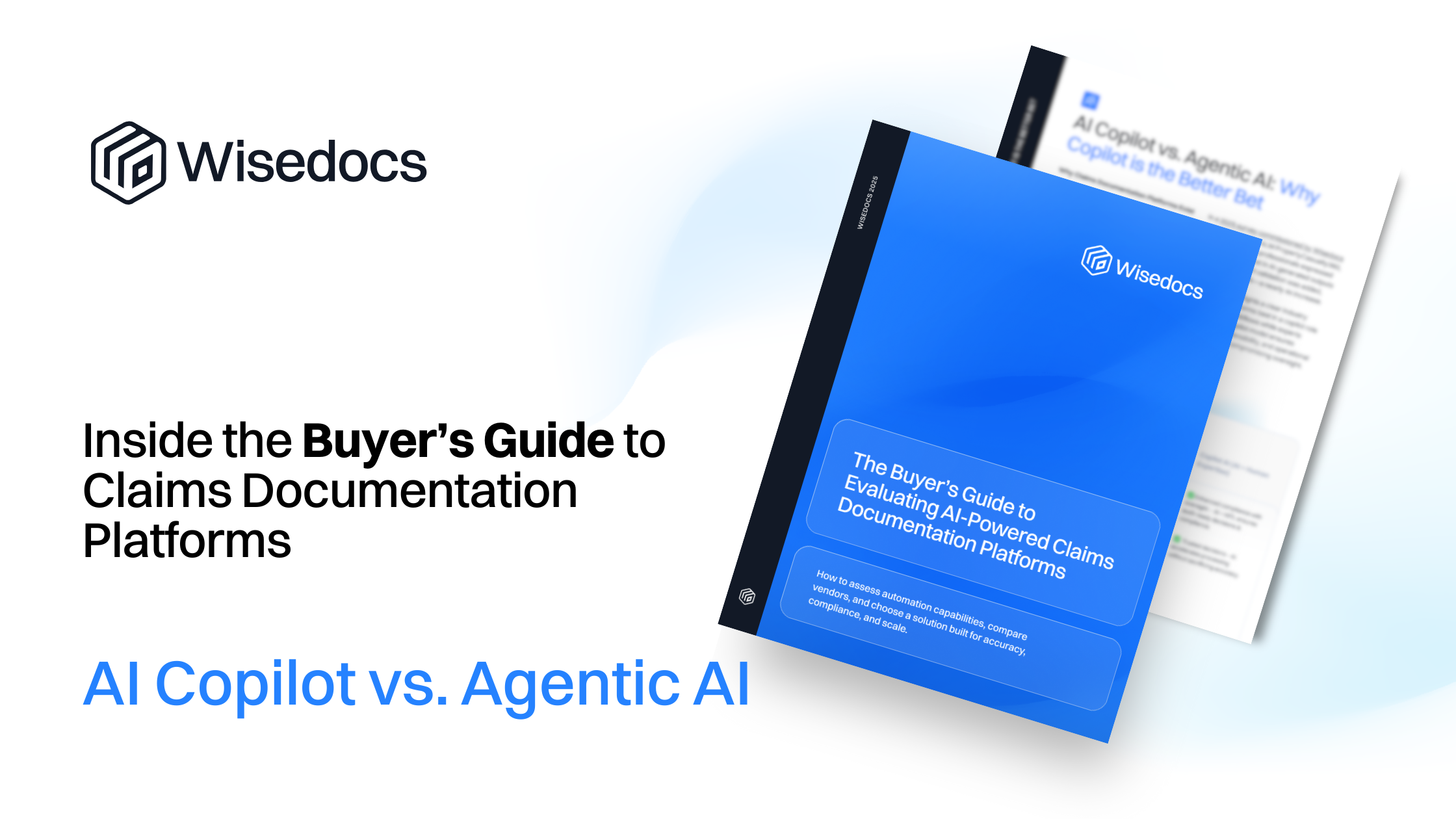A claims documentation platform helps teams deal with document overload, manual sorting, and duplicated information, in addition to powering through paperwork-heavy workloads and meeting requirements for compliance. In short, a claims documentation platform helps your team to work faster and smarter – reducing inefficiencies, costs, and processing delays.
Whether you’re choosing a new CDP or upgrading the one you already have, the Wisedocs Buyer’s Guide has everything you need to know about choosing the right solution for your firm. In this blog, we’ll cover everything you need to know about choosing between AI copilot or agentic AI.
AI Approaches to Claims Documentation: What Type of AI?
Deloitte predicts that half of generative AI companies will launch agentic AI pilots by 2027. What is agentic AI? Agentic AI is a ‘fully autonomous’ AI solution. While an AI assistant (like ChatGPT) might help you write a monthly summary email to your boss, the AI agent (agentic AI) will write it, schedule it, and send it for you with little to no human supervision.
But is it working? Gartner predicts that over 40% of agentic AI projects will be cancelled by the end of 2027. Agentic AI has been billed as the “next frontier” – but escalating costs, unclear value, and inadequate controls have made enterprise users reluctant to bring AI agents on board. Not surprising, considering that in a 2025 survey (commissioned by Wisedocs and conducted by ALM PropertyCasualty360), only 16% of claims professionals said that they trust AI generated outputs alone. When you add expert validation, that trust jumped to 58%: an increase of nearly 4x.
Imagine the same example as above: the monthly summary email to your boss. An AI agent can write it, schedule it, and send it for you. But would you feel comfortable with the result? For many people, the answer would be no – which is why using an AI copilot is perhaps the best model, especially in claims. Accuracy, legal defensibility, and efficiency are possible, while remaining compliant and offering expert human oversight.
AI Copilot is a Better Bet for Claims Documentation
For compliance, accuracy, and cost, you can’t beat the “copilot” model of AI. With the CDP software acting as an extension of the human expert, claims have enhanced compliance and are audit-ready. While purely human led (manual) claims review is accurate and legally defensible, manual reviews are time consuming and incredibly costly. Agentic AI is much higher risk, with AI generated decisions potentially leading to fines, disputes, and liability.
Similarly, human fatigue leads to greater error in manual review – and this error isn’t alleviated by agentic AI’s potential for misinterpretation. The speed savings from agentic AI might not be worthwhile in industries like claims, where the cost of cutting corners can be much too high.
Errors in claim handling from fully autonomous AI can result in massive legal payouts and affect the lives of claimants for years or decades. With rising regulatory penalties, legal disputes, and reputational damage, auditability and expert oversight are essential in an AI-powered solution such as CDPs.
Some CDPs use LLM “wrappers,” a new user interface or prompting tool added on top of an existing model, like ChatGPT. These off-the-shelf agent models can fall short for the industry specific documents required by claims, since they don’t have the in-depth claims knowledge or specialized training needed to produce accurate results for claims. Only 24% of generative AI projects have a component meant to secure the initiative, which isn’t always a fit in a heavily regulated industry like claims.
Benefits of AI Copilot for Claims
Copilot models of AI (a claims platform powered by AI but piloted by humans) ensures that your software tool is able to help the business scale, without introducing new risk. CDP copilot models help to remove irrelevant or redundant information, process hundreds or thousands of pages, identify and verify patterns within documents, scan handwritten pages, and generate industry relevant outputs. Claims teams can stay on top of their industry-specific needs, with high confidence in the results – making it faster, easier, and more efficient to process documents for claims.
The best path forward is to leverage the time saving benefits of AI, paired with the defensibility and confidence of human expertise. A copilot model keeps claims professionals, legal teams, and medical assessors in control while processing claims faster, more accurately, and in a legally defensible way. AI is the autopilot, but humans are the pilots ensuring a safe flight.
To learn more, check out the Wisedocs 2025 Buyer’s Guide for more details on finding a Claims Documentation Platform to fit your needs.


.png)


